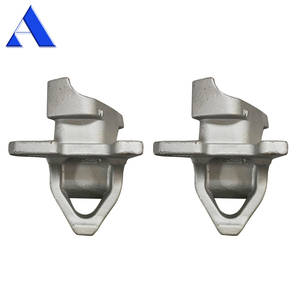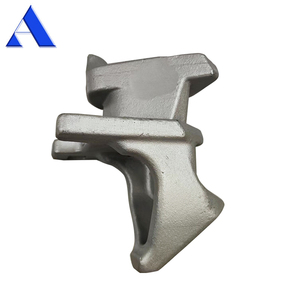(830 products available)













































































































































































































Shipping container fastener twist lock is a fundamental part of container security. It comes in various types, each designed to meet specific needs and offer varying levels of security. Here are some types of twist locks:
Standard Twist Lock
Standard twist locks are common in many shipping containers. They are easy to use and provide decent security. Standard twist locks are reliable and affordable. They are suitable for general shipping needs. Standard twist locks are easy to operate with a key or handle. They secure containers without complex locking mechanisms.
Secure Seal Twist Lock
Secure seal twist locks offer more security compared to the standard type. They are used in high-value cargo shipping. These locks prevent unauthorized access to the container. They are difficult to pick or cut, providing peace of mind to shippers. Secure seal twist locks are ideal for valuable goods that need extra security.
Reefer Container Lock
Reefer containers are refrigerated. They carry perishable goods. Reefer container locks are designed to secure temperature-controlled containers. These locks ensure that the containers remain sealed during transit. They protect the cargo from theft and tampering. Reefer container locks are vital for goods that need a specific temperature. They provide security and integrity of the cargo.
High Cube Container Lock
High cube containers are taller than standard containers. They have more interior space. High cube container locks are designed to secure these taller containers. They prevent theft and ensure that the containers arrive securely at their destination. High cube container locks are robust and durable. They withstand the rigors of shipping.
Bulk Container Lock
Bulk containers are used to transport bulk goods. These containers can be dry bulk, liquid bulk, or bulk refrigerated. Bulk container locks are designed for containers carrying large quantities of goods. They provide security for high-value shipments. Bulk container locks are effective and efficient in securing containers. They prevent theft and secure the cargo.
Intermodal Container Lock
Intermodal containers are used in different modes of transport. They are locked to secure cargo during transport. Intermodal container locks ensure that the cargo is safe. It can be moved across different modes of transport, such as road, rail, and sea. These locks provide security for international shipping. Intermodal container locks are convenient. They allow for seamless transport of goods across borders.
Manufacturers may use different materials to produce twist locks, and each material has its own specifications. Here are some general specifications to expect from a twist lock.
Material
The material used to make a shipping container twist lock is vital as it determines its longevity and strength. Most locks are made of high-quality steel. The steel material is strong and durable. It can withstand harsh environmental conditions and heavy cargo weight. Some twist locks are made of cast iron. This material is rust and corrosion resistant. Wholesalers can also find twist locks made of stainless steel. The stainless steel fastener twist locks are ideal for open-top containers and are corrosion resistant.
Size
Shipping container twist locks come in different sizes. The size of the lock depends on the type and purpose. For instance, the standard twist lock is 6 inches long and 4.5 inches wide. The size of the twist lock affects its strength and ability to secure containers.
Finish
The finish on a shipping container twist lock is important as it enhances its appearance and prevents corrosion. Manufacturers apply different finishes like hot-dipped galvanizing and electro-galvanizing. The locks with hot-dipped galvanizing finish are ideal for harsh environments like coastal areas. This is because the finish is thick and can resist corrosion.
Load capacity
Each twist lock has a load capacity specification. This is the maximum weight the lock can secure without damage. The load capacity varies depending on the type of lock. For instance, the standard twist lock has a load capacity of 20 tons. The load capacity is a crucial specification when choosing a twist lock.
Corrosion resistance
Some shipping container twist locks have features that make them more resistant to rust and corrosion than others. For example, they may have a special coating.
Security features
Some twist locks come with security features such as locks or keys.
It's important to ensure that the twist lock being used is compatible with the container and meets the specific security needs of the cargo being transported.
Maintaining shipping container fasteners is critical to ensure they last long and continue to perform their locking function. Here are some maintenance tips for container fasteners and twist locks.
Regular inspection
Users should regularly inspect container fasteners and locks to check for signs of wear and tear. They should inspect the fasteners for cracks, deformations, and breakages. The locks should be checked for rust and damage to the key hole. The earlier users detect problems, the easier it will be to fix and prevent them from worsening.
Regular cleaning
Container fasteners and locks should be cleaned regularly. This helps to prevent dirt and dust from accumulating, which can cause rust and corrosion. Users can use a soft cloth or brush when cleaning. They can also use mild soap and water. Container owners in coastal areas should clean the fasteners and locks regularly to remove salt deposits.
Lubrication
Twist locks and other container fasteners with moving parts require regular lubrication. Container owners should use a suitable lubricant like silicone spray. The lubricant helps to prevent rusting and ensures the moving parts work smoothly.
Protective coating
Users can apply a protective coating on twist locks and fasteners to prevent corrosion and rust. The coating protects the locks from harsh weather conditions.
Prompt repairs
Container owners should promptly repair or replace damaged fasteners and locks. They should inspect the containers regularly to identify damaged fasteners and locks. This prevents security breaches and ensures the container remains intact.
When choosing a twist lock for a shipping container, consider the following factors:
By considering these factors, buyers can choose a twist lock that meets their needs and provides adequate security for their shipping container.
Replacing a twist lock on a shipping container can be a straightforward DIY task, but it's important to ensure that it is done correctly to maintain the security and structural integrity of the container. Here's a guide on how to replace a shipping container lock fastener twist lock:
Tools and Materials Needed:
Step-by-step guide:
Container security is paramount, so ensure the new lock is functioning correctly before closing the container. If unsure about the installation, consult a professional to ensure proper fitting and security.
Q1: How many locks are on a shipping container?
A1: The number of locks on a shipping container varies depending on the design and size of the container. For a standard container, there are two locks on each end, totaling four locks. However, some containers may have additional locks for added security.
Q2: Are shipping container locks secure?
A2: Yes, shipping container locks are designed to be secure and provide a high level of security for the contents inside the container. They are made of strong materials and are resistant to picking, cutting, and other forms of tampering. However, like any security system, their effectiveness also depends on proper usage and additional security measures.
Q3: Can a shipping container be opened from the inside?
A3: No, a shipping container cannot be opened from the inside. Shipping containers are designed to be opened only from the outside, and there are no internal mechanisms or handles for opening them from the inside.
Q4: Can Twist locks be used on other types of containers?
A4: Yes, twist locks can be used on other types of intermodal containers, such as refrigerated containers. However, their primary design is for securing large shipping containers during transport.
Q5: Do shipping containers have locks?
A shipping container does have locks. Most shipping containers use a lock bar system. A standard 20-foot and 40-foot shipping container has two locks on each end, making a total of four locks.